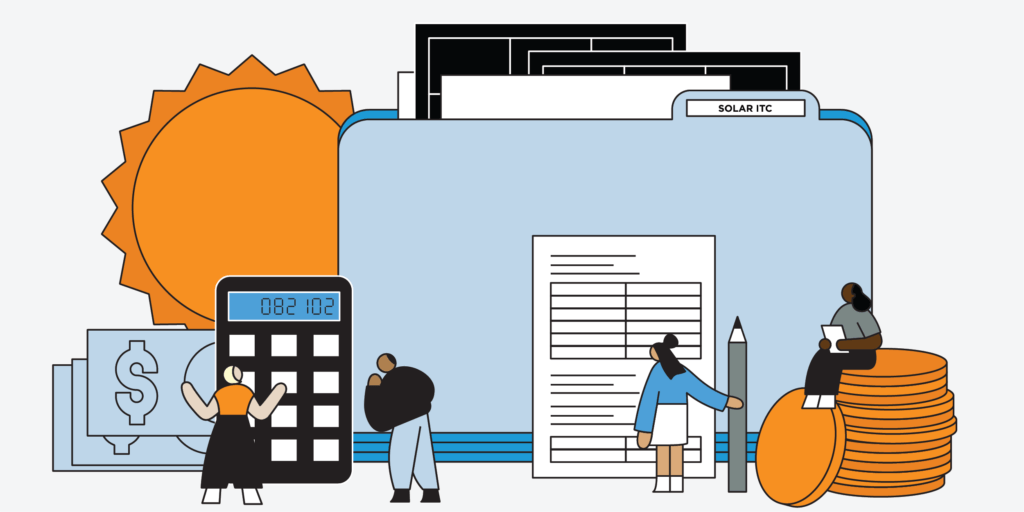
The solar industry has experienced an impressive average annual growth rate of 24% over the last 10 years. For homeowners eager to embrace renewable energy, the solar tax credit provides a significant financial incentive, facilitating the transition. Here we will provide a comprehensive breakdown of the solar tax credit, including key features, eligibility criteria, and the steps eligible homeowners need to take to claim this credit.
The Solar Investment Tax Credit (ITC) is a federal incentive in the United States of America allowing homeowners and businesses to deduct a percentage of their solar panel energy system installation costs from their federal taxes. Currently, the ITC offers a 30% credit on income taxes.

How Do I Claim the Solar Investment Tax Credit?
Claiming the ITC is done by filing IRS Form 5695 along with your federal tax return.
Here are step-by-step instructions on how to claim 30% on federal income taxes:
1. File IRS Form 5695:
-
- Download the Form: Obtain IRS Form 5695 from the IRS website or your tax preparation software.
-
- Personal Information: Fill out the required personal information at the top of the form, including your name and Social Security number.
2. Calculate the Credit on Part I of the Form:
-
- Line 1: Enter the total cost of your solar panel system on line 1. This includes all equipment and installation costs.
-
- Line 2: Multiply the amount on line 1 by 0.30 (30%) to calculate your potential ITC. Enter this amount on line 2.
-
- Line 3: Enter any other qualifying energy-saving improvements to your home.
-
- Line 5: Add the amounts from line 2 and 3 to get your total credit amount. Enter this total dollar amount on line 5.
3. Complete the Rest of the Form:
-
- Part II: If you have any other residential energy credits, fill out Part II of the form.
-
- Line 16: Enter the amount from line 5 on line 16.
4. Enter the Result on Your 1040:
-
- Transfer the Credit: Transfer the amount from line 16 of Form 5695 to line 5 of Schedule 3 (Form 1040). Then, include Schedule 3 with your Form 1040 when filing your tax return.
-
- Tax Liability: Ensure your tax liability for the year is at least as much as the ITC. If your credit exceeds your tax liability, the unused portion of the ITC will carry over to the next tax year.
5. Submit Your Tax Return:
-
- Attach Form 5695: Ensure Form 5695 is attached to your federal tax return.
Remember to keep all receipts and documentation related to your solar installation, as the Internal Revenue Service (IRS) may require proof of expenses. Following these steps carefully will help you claim your ITC correctly and maximize your savings on your federal income taxes.
Blue Raven Solar, LLC and its affiliates do not provide tax, legal or accounting advice. This material has been prepared for information purposes only. It is not intended to provide, and should not be relied on for, tax, legal, or accounting advice. Consult a tax and legal professional for more information.

Who Qualifies for Solar ITC?
Any taxpayer who lives in the United States of America and purchases a solar panel system for their primary or secondary residence is eligible. However, it’s important to note you must own the solar panel system to take advantage of the ITC. Those who are leasing their rooftop solar panel system or have a power purchase agreement (PPA) in place are not eligible to claim the credit.
Additional qualifications include:
- Your solar panel system was installed between January 1, 2017, and December 31, 2034.
- The rooftop solar panel system is in the United States of America at your primary or secondary residence.
- You own the solar system by purchasing it through cash or specific financing options.
- Your rooftop solar panel system is new or being used for the first time (the credit only applies to the “original installation” of the solar equipment).

How Much Can You Save with the ITC?
The ITC allows you to claim 30% of the total cost of your solar system with no maximums. For the average solar panel system size, the ITC represents about $7,500 in savings—a major reduction in the overall cost. However, the total credit varies based on the size of the system installed. A larger system will save more with the ITC than a smaller system.
Owners of solar systems installed between 2022 and 2034 are entitled to a 30% tax credit. Unless it is renewed by Congress, the ITC will expire in 2035. This credit can only be applied for once.
If the ITC exceeds the amount you owe in federal income taxes that year, the unused portion of the ITC is not lost but rolls over to subsequent tax years. For example, if your ITC was worth $7,500 but you only owed $7,000 in federal income tax, you could apply the remaining $500 ITC toward your federal income tax in the following year.
State and Local Solar Incentives
State and local solar incentives can also help reduce the upfront costs of installing solar energy systems. These incentives can include tax credits, rebates, grants, and other financial incentives provided by state and local governments.
When paired with the federal Investment Tax Credit (ITC), which provides a notable tax break covering a portion of the installation costs, the total financial advantages can be considerable. For example, a homeowner might receive a state rebate that covers 10% of the installation cost, and then apply the ITC to further reduce their tax liability by 30% of the remaining cost. By leveraging these combined incentives, homeowners can lower their initial investment, accelerating the adoption of solar energy and contributing to environmental sustainability.
Each state or city has different incentives available to solar owners, including state tax credits. Tax credits for solar energy are financial incentives provided by the government to encourage the adoption of renewable energy. For example, through the Renewable Energy Systems Tax Credit, Utah homeowners can claim 25% of solar system costs or $400, whichever is less when they go solar. The ITC can be combined with other state and local incentives to further reduce the overall cost of a solar installation. By taking advantage of both federal and local tax credits, individuals and businesses can significantly lower their initial investment, making solar energy more affordable and accelerating the transition to sustainable power sources. Learn more about the local incentives that apply to you.

Net Metering
Net metering is a billing arrangement through local utility companies. When their solar panels produce more electricity than is used, the surplus is sent to the utility company, and customers receive credits that offset their future energy consumption. While not every state participates in net metering, it is a great incentive for solar adopters to whom it is available. Combining net metering with the Investment Tax Credit (ITC) expands the financial benefits for solar energy users.
Tax Exemptions
Tax exemptions are another financial incentive available when making the switch to solar. Tax exemptions save money by limiting which taxes some solar customers must pay. The most common types of tax exemptions are property tax and sales tax exemptions.
- With a property tax exemption, solar adopters will not have to pay more in property tax when their property value increases after going solar.
- In states with sales tax exemptions, solar customers do not need to pay sales tax on the equipment installed, saving them money on the overall cost of their system.

Additional ITC FAQs
Making the decision to switch to solar requires you to weigh a variety of variables, and you may have additional questions about how the ITC applies to you and your specific situation.
Here are a few answers to commonly asked questions regarding the ITC. If you have additional questions, feel free to reach out to our team of solar experts.
Is the Solar Tax Credit a One-Time Credit?
Yes, the ITC is currently a one-time credit. You can only claim the credit once.
If the Tax Credit Exceeds My Tax Liability, Will I Get a Refund?
The ITC is a nonrefundable tax credit. This means you will not get a refund for the tax credit amount if it exceeds your tax liability. If you have overpaid your taxes during the year (which can often occur when employers deduct taxes from your paycheck), you may receive a refund. However, such a refund is still limited by your total tax liability.
If the credit exceeds your tax liability for the year in which you claim it, you can roll over the remaining amount of the credit to following years.
Is There a Dollar or Lifetime Limit on the Federal Solar Tax Credit?
No. There’s no dollar or lifetime limit on the tax credit. If a new solar panel system is being installed, the tax credit offers a 30% credit on the total installation cost. It is, however, a one-time credit.
How Blue Raven Solar Can Help with the ITC
At Blue Raven Solar, we are committed to delivering a world-class customer experience with a hassle-free solar installation process from start to finish. By choosing us, you can significantly reduce your energy costs while investing in a sustainable future.
Thanks to the federal Investment Tax Credit (ITC), homeowners can save 30% on the total cost of their solar system. This credit applies to installation expenses, solar equipment, materials, batteries, and the associated sales tax. With this cost-saving measure available for at least another decade, now is the perfect time to make the switch.
Discover how much you can save by going solar with Blue Raven Solar today.



Sorry, the comment form is closed at this time.